Archive for the ‘Reviews’ Category
Space Probe 6: Nightmare on Vega 3 (by Charles Huntington)




I’ve written numerous movie reviews, but this is the first time I’ve felt obligated to review a book. Obligated, in a “Look out! That man is about to throw a bucket of flesh eating bacteria on you!” kind of way. My opinion has always been not to criticize (in print) a book unless I knew without question I could write a better one.
Gentle Surfer, that day has arrived.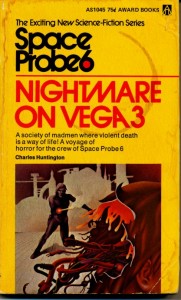
I acquired Nightmare from a former friend of mine. It appeared to be a classic, Heinlein-style pulp novel: the cover depicted a spaceman wielding a smoking light-saber (huh?), who had just blasted open someone’s skull to reveal some kind of anime’ tentacle-monster beneath. Okay, maybe not exactly Heinlein. But I thought it would be fun.
Passing a kidney stone is fun; this was painful.
The Space Probe 6 series features buff spaceman Matt Foyt and his intrepid sidekick Intra-Vehicular Android Navigator 3-69(M), aka Ivan (seriously). This is the point at which I should have closed the book. From there onward it gained momentum in a train-wreck sort of way: much as I wanted to look away, I could not–my eyes scanning line after line of text, the like of which has never before appeared in non-vanity print. Take a swig of Pepto-Bismol and check out some samples:
Action: As Matt was almost reaching Megnus, he was struck on the head and shoulders by a crate that had been hurled by the rawboned thug from the other side of the small room.
Technical: “Sequential system operative for automatic launch sequence,” Ivan reported to Matt.
Love: Matt returned the kiss and knew how she felt. It was not a happy thought to him that he would never see Ryana again after he blasted off Alcentar.
Sex: [Her large breasts] were full, perfectly shaped, and thrusting at him.
Now for the “story” itself. I’ll include page numbers, lest you think I’m making anything up.
Matt works for the Federated Space Agency (page 112), cruising the universe in his starship Scorpio at speeds up to warp factor twenty (page 8). Ivan says androidal stuff like, “That does not compute” (page 7). Matt lands on Vega 3, a planet where rape, murder, and assault are part of everyday life, and the government prevents victims from using lethal force in self-defense (much like Chicago or Washington D.C., but without pro football). After an encounter with a pterodactyl (page 14), Matt loses his memory and wanders the streets of Alcentar, a major city. In the course of his adventures, Matt fights off rodents of unusual size (page 52), gets into about two dozen fistfights with the locals (multiple citations); screws the lovely Ryana 2435, a native Alcentarn with huge breasts (many, many citations); and kills most of Alcentar’s population by incineration or bacteriologic gas (pretty much the entire novel). I guess the Federated Space Agency has yet to jump onto the Prime Directive bandwagon.
Struggling to regain his memory, Matt tries to protect Ryana from being murdered by her spurned lover Megnus 3712, save Ryana’s mother from mandatory execution on her 60th birthday, and rescue her sick brother from almost certain death. He fails at all three, but at least he has the best sex of his life in the process.
And for the record, no tentacle-brained aliens ever appeared in the book. (If something wasn’t good enough to appear in Star Trek or Lost in Space, then by God it wasn’t good enough for Nightmare!)
In summary, this book is the Plan 9 from Outer Space of novels. But at least in Plan 9, Bela Lugosi had the decency to die before it was completed. Charles Huntington showed his audience no such compassion.
The most astonishing aspect of the book is that it’s a sequel! Both creations were foisted upon the unsuspecting world by Award Books in New York. I could find no Internet references to a third; I imagine after Nightmare hit the shelves, the citizens of the Big Apple took up pitchforks and lanterns, stormed the publishing house and dragged out the publisher, covered him with hot tar and chicken feathers, chained him to a railroad tie, threw him into the Hudson River, then returned to the building, burned it to the ground, buried the ashes, salted the earth on which it had stood, and staked the author’s head on a pike as a warning. But being New Yorkers, they might not have been so polite.
(Sidenote: My Internet search did turn up something called the Deep Space Probe 6-Speed Butt Plug. I’ll leave you to draw your own inferences.)
I feel I must apologize to Mr. Heinlein for thinking anything in this book might have been in any way reminiscent of anything Mr. Heinlein ever wrote, thought, or dreamed in his darkest nightmares. Indeed, I apologize for even mentioning him in the same article as Nightmare on Vega 3. In fact, I think Congress should pass a federal law stripping Charles Huntington of the first letter of his last name, lest some lone copy of his work escape destruction and end up in some roach-infested used-book store in the same section with any book ever written by Heinlein.
Indeed, my greatest fear in writing this review is the infinitesimal chance that it could lead to a demand for Nightmare to reappear in print, much like Mystery Science Theater 3000 did for Manos: The Hands of Fate. This is scarcely the legacy for which I hope to be remembered:
“Terry Burlison? Wasn’t he the guy who invented the zero-point energy cell, eliminating all pollution and providing inexpensive, safe energy for the entire world, freeing billions from poverty and ushering in a new era for humankind?”
“Yeah, but he also led to the reprinting of the Space Probe 6 series.”
“The bastard!”
So, please, please, please do not try to find this book. Do not search for it, do not call your local used book stores, do not mention it to others, do not even think too loudly about it. If you are so full of self-loathing that you want to read it for yourself, contact me and I’ll send you my copy.
I’ll even pay the shipping.
All Rights Reserved
Star Trek: The Motion(less) Picture–Director’s Ed.




“Fool me once, shame on you. Fool me twice, shame on me.” (Scotty to Sulu in the Star Trek episode, “Friday’s Child.”)
I went to see the original Star Trek: The Motion Picture when it was released in 1979. I was astounded by the great special effects; even more so by the stupid plot, terrible acting, and–most of all–the plodding pace.
Recently, Paramount decided to release a “Director’s cut” of the movie. Director Robert Wise had never been completely happy with the original release (imagine that), and wanted to turn it into the movie he had set out to make. Since Wise has directed several movies that didn’t suck, including The Sand Pebbles, The Andromeda Strain, West Side Story, and something called The Sound of Music, I had high hopes.
It’s amazing what a few edits, improved sound, and updated visual effects can do. Wise has turned a two 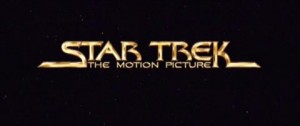 hour, twelve minute piece of crap into a two hour, sixteen minute piece of crap.
hour, twelve minute piece of crap into a two hour, sixteen minute piece of crap.
PARENTAL WARNING: This movie is rated “PG” for “Sci-fi Action and Mild Language,” whatever the hell that means.
ST:TMP sets a new Hollywood record by sucking three minutes before the movie even starts. Wise decided to get the viewer acclimated to the movie’s pace by starting with a one hundred-eighty second shot of stars moving toward the center of the screen, kinda like the old Windows screen saver in reverse.
Any viewers still awake then get to watch the jazzy opening credits, followed by the great scene of three Klingon cruisers filled with heavy smokers getting vaporized by the Great Death Cloud from Outer Space.
Enough action. Back on the planet Vulcan, we discover Spock has decided to leave the Kohlinar Renaissance 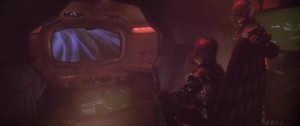 Fair and rejoin his lesser human comrades. He had returned home to eliminate any last vestige of emotion. He succeeded, and immediately was rewarded with a contract offer from Paramount
Fair and rejoin his lesser human comrades. He had returned home to eliminate any last vestige of emotion. He succeeded, and immediately was rewarded with a contract offer from Paramount
We now jump to Star Fleet Headquarters in San Francisco where they are celebrating Gay Pride Week, judging by the uniforms. Admiral James Kirk has been reassigned to the upgraded U.S.S. Enterprise. The Death Cloud is heading for Earth and, due to phenomenally bad deployment orders from Star Fleet Command, there are no starships in that half of the galaxy. Only the Enterprise stands between us and almost certain excitement.
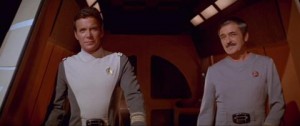 Kirk and Scotty board (or is that “bored”) a shuttle and spend a week or two flying around the Enterprise, since Scotty won’t call and ask for directions to the docking port. Eventually, they find their way aboard where Kirk discovers his bridge has been painted entirely in brown primer. Kirk finds the ship’s real captain, fifteen-year-old Will Decker (Stephen Collins), and informs him that “rank hath its privileges,” which sadly included script control.
Kirk and Scotty board (or is that “bored”) a shuttle and spend a week or two flying around the Enterprise, since Scotty won’t call and ask for directions to the docking port. Eventually, they find their way aboard where Kirk discovers his bridge has been painted entirely in brown primer. Kirk finds the ship’s real captain, fifteen-year-old Will Decker (Stephen Collins), and informs him that “rank hath its privileges,” which sadly included script control.
Emergency! The Enterprise‘s transporter is malfunctioning in the process of beaming up the ship’s Science Officer! Kirk rushes to the scene, shoulders the transporter chief (the formerly gorgeous Yeoman Rand) aside, and proceeds to melt the two upbound crewmen. Ever the sensitive Captain, he assures Rand, “It wasn’t your fault,” and walks away.
Kirk assembles the entire crew to show them Star Fleet’s home movie of the Klingon ships getting utterly disintegrated by the unimaginable power of the Death Cloud. He then patches into a live feed from a Star Fleet space station directly in the cloud’s path. The station is also utterly destroyed, except for the exterior cameras which continue to function long after the Death Cloud passes. (Note to Star Fleet engineers: Build the stations from the same material you used for the cameras.)
Having inspired his crew with the utter hopelessness of their mission, Kirk returns to the bridge. Here we meet the sexy Lieutenant Ilia, a Deltan. Deltans love being bald (as does Captain Kirk), and she warns Kirk up front that her “oath of celibacy is on record.”
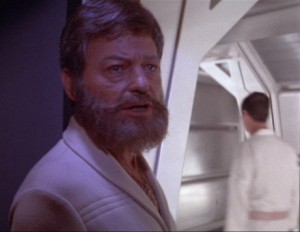 The lovably irascible (and heavily bearded) Doctor McCoy now beams up, cutting short his tour with ZZ Top. For some inexplicable reason, he didn’t completely trust the transporter, maybe because of the two piles of protoplasm left over from the last time someone tried to come aboard. Kirk tells McCoy, “I need you. I need you–badly!” which should lay to rest all the rumors of a Kirk/Spock romantic entanglement. McCoy heads off to sickbay to make Doctor Chapel’s day by demoting her back to bedpan jockey.
The lovably irascible (and heavily bearded) Doctor McCoy now beams up, cutting short his tour with ZZ Top. For some inexplicable reason, he didn’t completely trust the transporter, maybe because of the two piles of protoplasm left over from the last time someone tried to come aboard. Kirk tells McCoy, “I need you. I need you–badly!” which should lay to rest all the rumors of a Kirk/Spock romantic entanglement. McCoy heads off to sickbay to make Doctor Chapel’s day by demoting her back to bedpan jockey.
The Enterprise finally leaves orbit. After Kirk accidentally drives the ship into a wormhole, a Vulcan shuttle arrives and delivers Mr. Spock, sporting his classic 1966 haircut and wearing a black dress. Kirk then breaks McCoy’s heart by announcing, “I need him, Bones!” and reignites the old rumors.
The Enterprise finally reaches the Death Cloud, and Kirk orders the ship in. For the next several days, we watch:
Kirk stare at the viewscreen.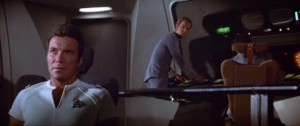
Spock stare at the viewscreen.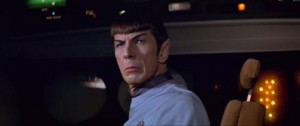
Sulu stare at the viewscreen.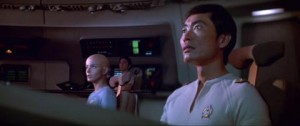
Chekov stare at the viewscreen.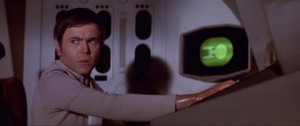
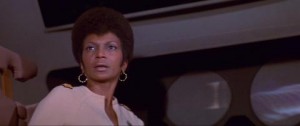
Decker stare at the viewscreen.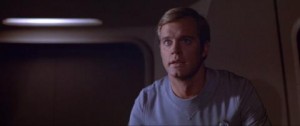
Ilia stare at the viewscreen.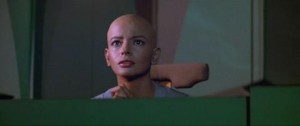
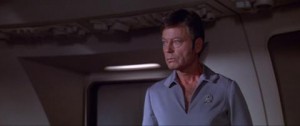
Several combinations of the above.
Repeat until budget overrun.
Eventually, the Death Cloud gets tired of being ogled and sends a pillar of fire onboard the bridge. It bounces around and finally dissolves Ilia. Everyone on the bridge blinks heart-rendingly, then Kirk calls “Next!” Another young woman arrives 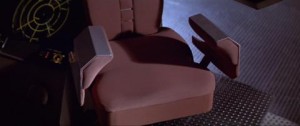 and takes Ilia’s place, but not before staring with some concern at the scorch marks on her seat.
and takes Ilia’s place, but not before staring with some concern at the scorch marks on her seat.
Kirk cleverly gets the Enterprise trapped in the bowels of the Death Cloud. Ilea re-appears, completely naked but behind a shower stall. She emerges, miraculously clothed in a crotch-length bathrobe and announces she is a “probe” from the cloud, which is called “V’Ger.” We discover she is now an automaton, completely unable to feel or project any emotion whatsoever. She fits in perfectly.
Spock now decides to assault a fellow officer, steal a spacesuit, and venture outside the Big E. He awaits the perfect 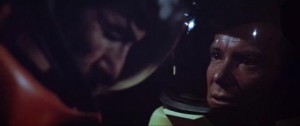 moment, then hurtles himself through V’Ger’s Enormous Space Sphincter. Once inside, he discovers the cloud is actually a giant hi-def TV. He attempts to mind-meld with it, which expels him back through the sphincter and into Kirk’s waiting arms.
moment, then hurtles himself through V’Ger’s Enormous Space Sphincter. Once inside, he discovers the cloud is actually a giant hi-def TV. He attempts to mind-meld with it, which expels him back through the sphincter and into Kirk’s waiting arms.
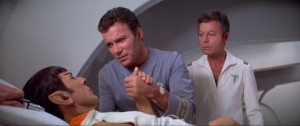 Back in sickbay, Spock awakens, grinning like an idiot, and tells everyone he’s seen the error of his ways and is ready to embrace humanity. He starts by holding hands with Kirk.
Back in sickbay, Spock awakens, grinning like an idiot, and tells everyone he’s seen the error of his ways and is ready to embrace humanity. He starts by holding hands with Kirk.
V’Ger arrives at Earth. It tries to communicate with our planet, but is foiled by the copy-protection technology on all our electronic devices. So it decides to obliterate our world.
Spock, back on the bridge, faces Kirk, a single tear rolling down his cheek, and asks, “Why am I here?”
So did I.
The Enterprise makes its way through the big sphincter and finds V’Ger’s heart. Kirk and company leave the ship and discover V’Ger is actually a NASA probe that was lost three hundred years ago due to a Y2K bug. V’Ger, it turns out, has wandered the cosmos for centuries, alone, and is unimaginably horny. Kirk, ever willing to put his own probe “where no man 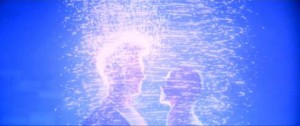 has gone before,” is disappointed to discover the V’Ger/Ilia probe wants to “join” with Decker. The two come together in a colossal orgasm that throws Enterprise clear and most likely knocks out all communication on the Earth for decades.
has gone before,” is disappointed to discover the V’Ger/Ilia probe wants to “join” with Decker. The two come together in a colossal orgasm that throws Enterprise clear and most likely knocks out all communication on the Earth for decades.
Kirk then settles in to his captain’s chair and orders the Enterprise away from Earth, probably so he won’t have to bother with all the paperwork for the four dead and missing crewmen from his first mission back.
Okay, those of you who saw the original release (and remained conscious through it) are probably wondering: “What the hell was different?” Well, the differences are obvious to anyone who watches the supplemental material on the DVD.
New visual effects: Several of the original effects were not what Wise wanted, so he decided to replace them. In a move that no doubt came as a surprise to the check-writers at Paramount, the new artists decided to create brand-spanking new visuals whose quality would be indistinguishable from those done in 1979! All the way down to “the dust on the film.” (Actual quote.) So basically they took what are (by today’s standards) mediocre visual effects and replaced them with mediocre optical effects.
The Opening: It seems that three of the additional four minutes in the Director’s Cut are–believe it or not–the new opening sequence of stars going in reverse! In fairness, adding this pointless, mind-numbing scene did improve the overall pace of the movie.
Editing/trimming: In some scenes, as much as several seconds were mercilessly hacked out of the new release. Ironically, the movie would have been better off if they had kept those seconds and thrown the rest away.
If you’ve seen the original Star Trek: The Motion Picture, there’s no need to spend several weeks watching it again.
Still four vacuums.
All Rights Reserved